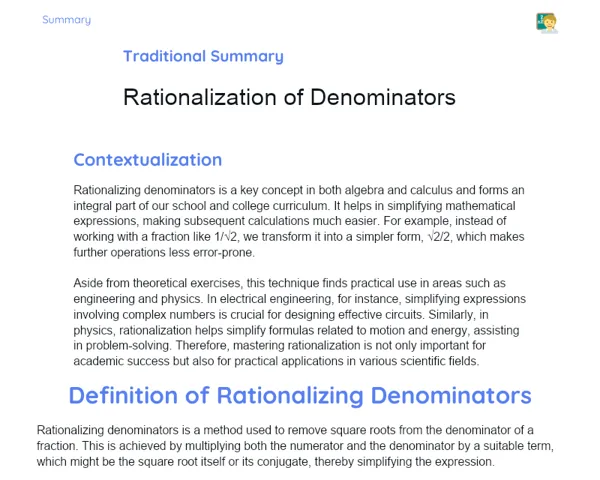Objectives
1. Identify and differentiate between prime and composite numbers.
2. Establish divisibility rules for 2, 3, 4, 5, 6, 8, 9, 10, 100, and 1000.
3. Apply the knowledge acquired in everyday situations as well as in advanced academic contexts.
Contextualization
Did you know that prime numbers play a crucial role in the security of many digital systems? In the world of cryptography, very large prime numbers are essential for safeguarding sensitive information such as online banking and government records. This is because factoring these massive numbers is an extremely tough task, even for the most advanced computers. This direct connection between prime numbers and cybersecurity underscores how vital these mathematical concepts are in our day-to-day lives.
Important Topics
Prime Numbers
Prime numbers are those greater than 1 that can only be evenly divided by 1 and themselves. They underpin many mathematical principles and practical applications, including cryptography and factorization. The special characteristic of prime numbers, which stands strong against division by any other number except 1 and itself, is critical for the integrity of many modern digital systems.
-
Prime numbers begin at 2, which is the only even prime number.
-
They cannot be broken down into a product of smaller integers apart from 1 and the number itself, which makes them fundamental in number theory.
-
There are infinitely many prime numbers, a fact established by the mathematician Euclid in his book 'Elements.'
Composite Numbers
Composite numbers are those that have more than two divisors, meaning they can be divided by 1, by themselves, and by at least one other number. They are the converse of prime numbers and are key to grasping divisibility concepts. Understanding composite numbers is essential for tasks such as factoring, which is vital in various areas of mathematics and computing.
-
The number 1 is classified as a unit and does not fall under either prime or composite, as it doesn't meet the conventional definitions.
-
The smallest composite number is 4, which can be expressed as 2x2.
-
Composite numbers have a significant role in cryptography, especially in generating public and private keys.
Divisibility Rules
Divisibility rules are simple guidelines that assist in determining whether one number can be divided by another without carrying out the actual division. These rules are extremely valuable in foundational mathematics and serve as a stepping stone to understanding the properties of numbers in various contexts, including factorization and fraction simplification.
-
A number is divisible by 2 if the last digit is 0, 2, 4, 6, or 8.
-
To check divisibility by 3, simply add up the digits of the number and see if the sum is divisible by 3.
-
The divisibility rule for 9 is similar to that for 3: the sum of the digits should be a multiple of 9.
Key Terms
-
Prime Numbers: Numbers greater than 1 that can only be divided by 1 and themselves.
-
Composite Numbers: Numbers that have more than two divisors, in addition to 1 and themselves.
-
Divisibility Rules: Guidelines that help determine if one number is divisible by another without performing division.
For Reflection
-
Why are prime numbers so vital in the realm of cryptography? How does this impact our online security?
-
How can understanding divisibility rules streamline the process of solving complex mathematical problems?
-
In what ways can the study of prime and composite numbers be applied in everyday life outside of the classroom?
Important Conclusions
-
We examined the critical difference between prime and composite numbers, realizing how essential primes are in fields such as data encryption.
-
We have learned to apply divisibility rules to identify easily whether one number can be divided by another, which is useful in many mathematical and practical situations.
-
We discussed the significance of prime and composite numbers in the real world, highlighting how these mathematical concepts influence our daily lives and are crucial to various modern technologies.
To Exercise Knowledge
Create a 'Number Diary' where you jot down every number you encounter throughout the week and classify them as prime or composite. Challenge yourself to factor larger numbers into their prime factors and confirm your answers with a calculator. You can also play the game 'Factorization Race' with a friend: choose a number and see who can factor it out faster!
Challenge
Giant Prime Challenge: Work on finding the largest prime number you can by using division and factorization techniques. Use online resources to check if your number is genuinely prime and share your discoveries with the class!
Study Tips
-
Practice divisibility rules regularly by attempting mental divisions to check if one number divides another.
-
Explore math apps and online games that visually demonstrate and help you understand the concepts of prime and composite numbers in a fun and interactive manner.
-
Try teaching the concepts you've learned to a friend or family member. Teaching is an excellent way to reinforce your own understanding and identify any gaps in your knowledge.



